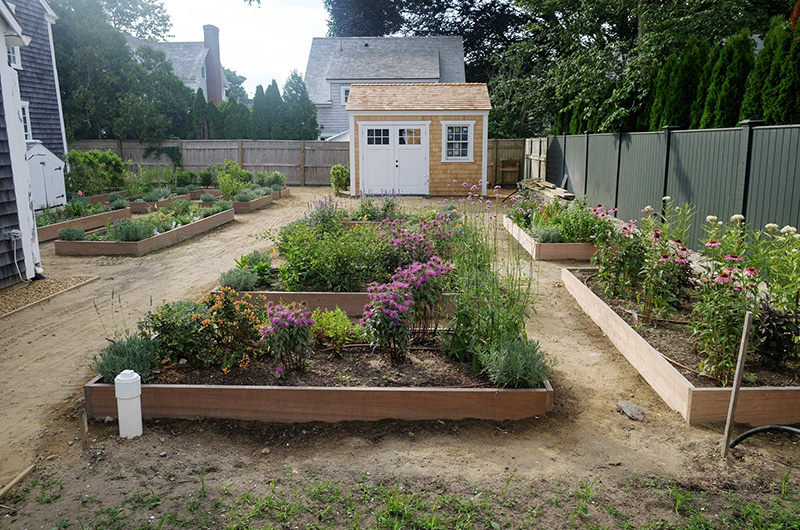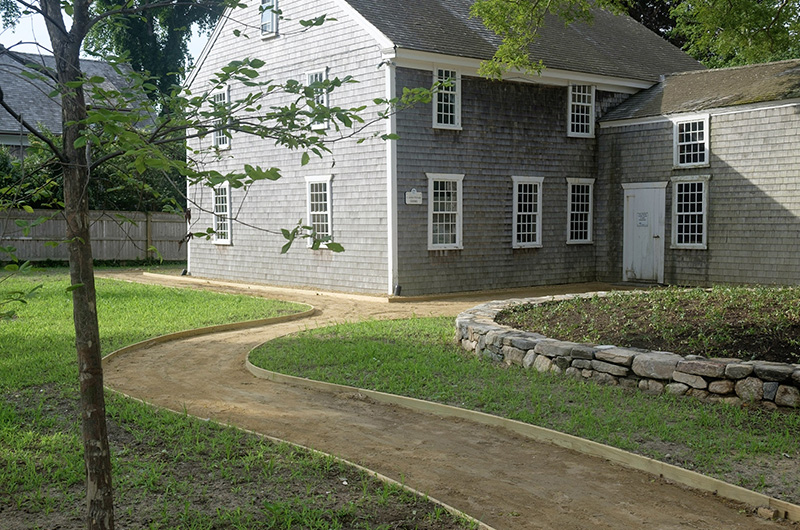Cars drive past the corner of Cooke and School streets in downtown Edgartown on a bustling Monday afternoon while construction sends sand swirling in the air. The afternoon is buzzing with activity and yet, a few blocks from Main street, the Thomas Cooke House sits quietly on the old grounds of the Martha’s Vineyard Museum.
A vestige of old-world Edgartown and a living piece of town history, the house is a still point in a busy day.
For three years now, the museum has been hard at work restoring the historic Cooke house property, the site of its original campus, as a public green-space and satellite campus. Plans for the project include repairing the Cooke house as well as constructing an interpretive nature trail around it, called the Legacy Gardens, that will honor the Island’s horticultural history.
Interim executive director Heather Seger explained that when the museum began work on the project in 2017, right around the time they relocated to the old marine hospital in Vineyard Haven, they did so with one goal in mind—preserving the site’s history in the midst of a quickly developing downtown.

“As a museum, history is everything to us and the Cooke house is a really important part of the museum’s history,” she said. “We wanted to continue to have a [site] in Edgartown that connected us to our historic home and told the story of the town from its beginnings, all the way through.”
To give a sense of that history, the Cooke house is the oldest house in Edgartown still in its original location. Constructed in 1740 and once home to the town customs officer, Thomas Cooke, the house has a long and storied past that reaches back to the founding of Edgartown.
As Ms. Seger explained, from its perch on Cooke street the house has witnessed centuries of Vineyard history—from the Island’s beginnings as a colonial settlement, to the rise and fall of its whaling industry, to present day.
The museum plans to use the restored Cooke house and its Legacy Gardens to tell the story of Edgartown through the ages, honoring its long history.
Spearheaded by landscape architect Cheryl Doble with the help of volunteer and donor Nancy Vietor, the grounds will form one large loop, or “learning loop,” that passes through a series of gardens, each devoted to a different era of Island history. The story will be told, in part, through nature, with each garden outfitted with native plants and stylized landscaping specific to the time period it represents.
“For me to start, you know 5000 BC, and start walking around back around to 2020 is really quite something,” said Ms. Vietor, whose family has also donated a garden to the project. “This garden is going to be telling stories.”

Ms. Vietor added that preserving the site’s history was not just a matter of looking to the past. In partnership with private donors, the museum was able to secure $500,000 to place a permanent conservation restriction on the property, prohibiting future building.
“[There’s] a quote from T.S. Eliot, and it’s called the still point in a turning world. Every time I go to the Cooke house and I get into the gardens, I think this is the still point in a turning world,” she said. “For a busy summer town, there will be this place where you can take a walk through time...and it will be there forever.”
Today, the project is well under way. The winding path that will cut through the finished gardens is now visible from the street and the pagoda tree at the center of the property is in full bloom for the first time this summer.
The restoration of the house itself is still in its infancy, but Ms. Seger said that when completed, the museum plans to use the space to host an array of activities for children and adults. The site will also feature outdoor educational programming like dyeing clothing with native plants and learning about the medicinal and culinary uses of herbs grown on the Island.
Despite minor setbacks caused by the pandemic, Ms. Seger said that the museum expects the gardens will be open to the public next summer, with work continuing this season and plans for more planting in the fall. The site will also be open for walkthrough visits later this summer.
As construction and planting continues on Cooke street, Ms. Vietor hopes that the generous donations from the Edgartown community and museum patrons will continue to propel the project forward.
As for Ms. Seger, she hopes the new space will remind Islanders that everything from the sand to the bushes to Edgartown’s Main street is part of the Vineyard’s rich history.
Ms. Vietor echoed this sentiment. “Take a moment and go back in time, see what it was like,” she said. “I think that’s the real gift.”






Comments (1)
Comments
Comment policy »